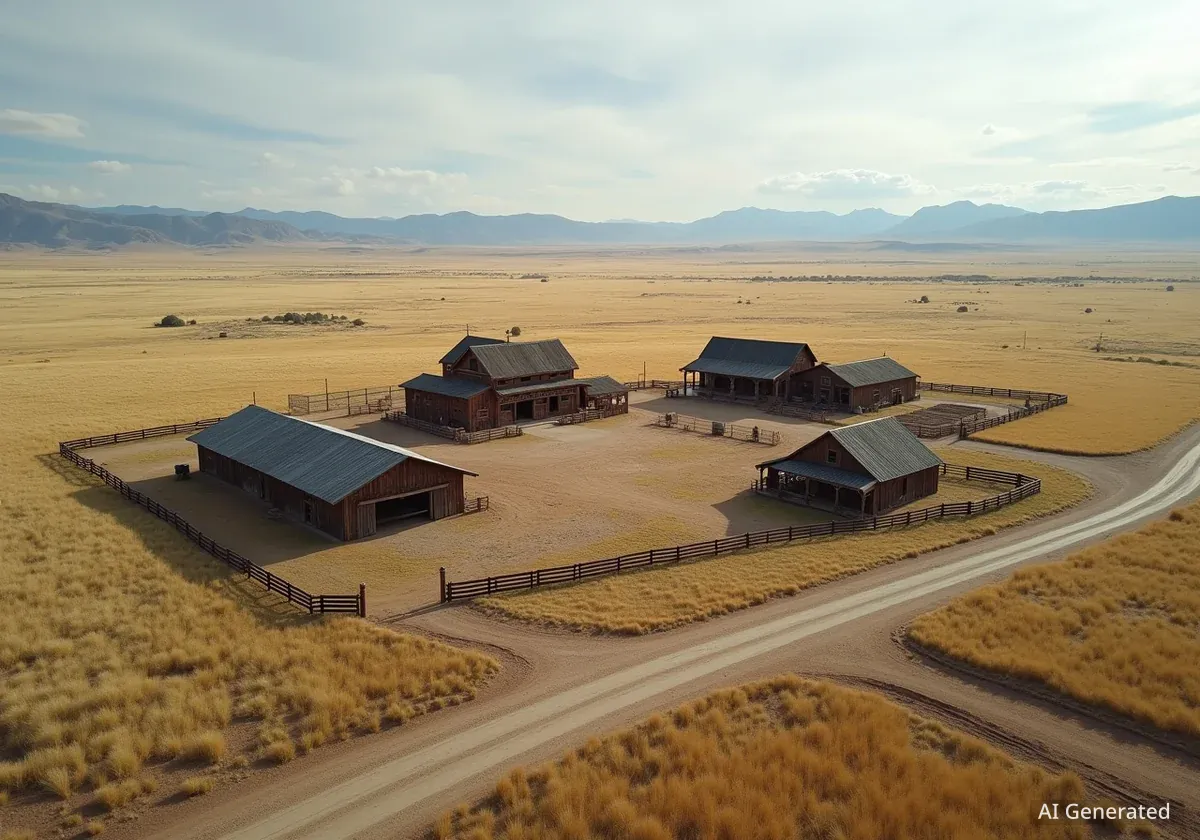A historic Wyoming property with a direct link to the infamous Wild West outlaw Butch Cassidy is now on the market. The Old Pitchfork Ranch, the original headquarters of 19th-century cattle baron Otto Franc, has been listed for sale at $7.95 million. This 288-acre property near Meeteetse played a pivotal role in the event that led to Cassidy's only prison sentence.
The sale includes several restored original structures from the 1870s, offering a unique piece of American frontier history. The listing is managed by Live Water Properties, highlighting its deep connection to the lore of Wyoming's ranching and outlaw past.
Key Takeaways
- The 288-acre Old Pitchfork Ranch in Wyoming is listed for $7.95 million.
- The property was the headquarters of cattle baron Otto Franc, who filed the horse theft charge that imprisoned Butch Cassidy.
- This charge led to Cassidy's only prison term in 1894, a turning point in his life as an outlaw.
- The ranch features meticulously restored historic buildings, including Franc's original adobe home and a cowboy bunkhouse.
- Current owner Greg Luce purchased the property in 1992 and spent decades restoring it from a state of ruin.
A Property Steeped in Frontier History
The Old Pitchfork Ranch holds a significant place in the history of the American West. Established by Otto Franc around 1878, it stands as the second oldest ranch in its region. Franc, a former banana tycoon who became a powerful Wyoming cattleman, built his headquarters along the Greybull River.
The property's legacy is intertwined with one of the most famous figures of the era, Butch Cassidy. While it is not confirmed that Cassidy ever worked directly for Franc, their paths crossed in a way that would alter the course of the outlaw's life forever.
"The Old Pitchfork Ranch isn’t just land — it’s the original headquarters of Otto Franc," said Latham Jenkins of Live Water Properties. "(He) helped shape the identity of Wyoming ranching. When you step onto this property, you’re walking into the very place where the Pitchfork story began more than a century ago."
The Johnson County War
The events connecting Franc and Cassidy occurred during a turbulent period known as the Johnson County War and a lesser-known horse thief war. This era was defined by violent conflicts between large, powerful cattle ranchers and smaller settlers, whom the ranchers often accused of rustling. The powerful cattle barons sometimes hired gunmen to eliminate their rivals, creating a lawless and dangerous environment on the Wyoming range.
The Infamous Connection to Butch Cassidy
The ranch's most notable claim to fame is its connection to Butch Cassidy's only incarceration. In 1894, Otto Franc filed a horse theft charge against Cassidy. This was the second such charge against the outlaw; a previous one had just been dismissed.
Franc filed the charge on behalf of another rancher. However, Cassidy always maintained his innocence, claiming he was framed. He believed the charge was a tactic by powerful cattlemen to seize his own livestock and force him out of the area.
Regardless of the truth, the charge stuck. It resulted in Butch Cassidy being sentenced to prison. According to historical accounts, Cassidy was enraged by the conviction, vowing revenge and blaming Franc for pushing him into a full-time life of crime. He claimed he would have lived an honest life if not for the prison term.
A Turning Point for an Outlaw
Butch Cassidy's prison sentence, stemming from the charge filed by Old Pitchfork Ranch owner Otto Franc, began in 1894. This event is widely considered the catalyst that transformed him from a small-time rustler into the leader of the notorious Wild Bunch gang.
Restoring a Neglected Landmark
When current owner Greg Luce acquired the property in 1992, the historic headquarters was in a state of severe disrepair. The original structures were dilapidated, with Franc's adobe home left open to the elements.
"There were no doors on it," Luce told Cowboy State Daily. "There were no windows in it. Cattle were unabashedly walking through what had once been the cattle baron’s home."
Despite the decay, Luce saw the historical value and structural integrity of the buildings. "It was amazingly sound, that’s what our engineers found," he said. This discovery launched a decades-long, phased restoration project to save the historic site.
A Phased and Careful Restoration
The restoration began with the log cabin bunkhouse where Franc's cowboys once lived. This was a more manageable first step. "We had the logs pulled, numbered, and cleaned off," Luce explained. "New chinking was applied after that and then they were rebuilt into the original form of the cabin."
Luce and his wife lived in the restored bunkhouse while they planned the more complex restoration of the main adobe residence. The adobe house had no modern utilities—no water, electricity, or plumbing.
Working with an architect, Luce aimed to restore the building as accurately as possible while making it suitable for modern living. The project involved restoring the original wing and adding a new, perpendicular wing that mirrored the original's style and proportions. The new addition provides modern amenities while respecting the historical aesthetic.
Inside the Historic Property Today
The restored main residence is a blend of history and modern comfort. The original adobe structure features impressive 18-inch-thick walls, built to withstand potential attacks on the frontier.
The interior showcases high-quality craftsmanship and materials that honor the ranch's heritage. Key features include:
- River-recovered longleaf heart pine flooring.
- River-recovered cypress ceilings and beams.
- Custom cabinetry by Norseman Designs West.
In addition to the main home and bunkhouse, the property also includes a cabin that was moved from the adjacent, larger Pitchfork Ranch. This cabin was reportedly a favorite of famed aviator Amelia Earhart during a time when the neighboring ranch operated as a dude ranch.
Adjacent Ranch Also for Sale
The neighboring Pitchfork Ranch, a massive 96,115-acre property, is also available in a separate listing for $52.8 million. Luce expressed hope that a single buyer might purchase both properties to reunite the historic ranch lands.
A New Steward for a Wyoming Legacy
For Greg Luce, selling the Old Pitchfork Ranch is an emotional decision. He describes the decades-long restoration as a "labor of love and money."
"I told Latham after I looked through the listing... ‘Latham, let’s call the whole thing off. I don’t know how we’re gonna leave here,'" Luce admitted. However, he recognizes it is time to pass the property to a new owner who can continue its legacy.
Luce feels it is time for a new steward to take over the historic property. "My kids love the ranch," he said. "But my kids are not going to want to love the ranch and be ranchers." He believes it is the right time to find someone who will appreciate and preserve this unique piece of Wyoming's history.





